Abstract
Microplastics, which are defined as small plastic particles smaller than 5 mm, have been found in various aquatic environments all over the world. In this study, we investigated the level of microplastics in the surface water and estuarine mullet Mugil cephalus from 23 estuary areas in the south of China. M. cephalus, due to its wide distribution and high tolerance, was selected as a candidate fish species for monitoring the ingestion of marine microplastics. The size, color, and type of all microplastics were recorded from the water and fish samples by stereomicroscope. The average abundance of microplastics was 18,261 items/m3 in the surface water, and 7.2 items/individual in fish. These alarming numbers revealed significant pollution due to microplastics in the environment. Fragments and minute-sized particles were the most common features found in both the water and the fish samples. Some impurities in the water sample were easily confused with microplastics, but regular forms on the surface of the impurity could be distinguished by using scanning electron microscopy (SEM). The shape, color, and size of the microplastics in the fish and water samples were similar, which suggested that the microplastics in the water might enter the organisms’ body, thereby affecting the health of aquatic species and even humans. Based on these findings, it is highly recommended that the monitoring and managing of pollution due to microplastics be addressed in the estuaries.
1. Introduction
Small plastic particles (<5 mm) known as microplastics [] have accumulated in the ocean on a global scale []. To date, approximately 4066 species have been documented to be affected by marine debris (http://litterbase.awi.de/interaction_detail (accessed on 30 January 2023). Detailed information regarding the incidence of microplastics in fish worldwide can be found in Carbery et al. [] and Jacob et al. []. Microplastics come from two sources. Primary microplastics, such as microbeads in facial cleansers [], are made in sizes smaller than 5 mm. Secondary microplastics refer to microplastics less than 5 mm that aged or underwent abrasion after a physical and chemical action during use or transportation. These plastics originated from discarded small-sized plastic products and other plastics such as worn fishing net fibers. Accumulated microplastics could be used as vectors for the transport of heavy metals [,] and persistent organic pollutants [,]. This phenomenon has drawn increasing attention to the harmful effects on marine organisms and the potential harm to human health [,].
The mullet Mugil cephalus is a kind of demersal fish with a wide range of habitats. It is commonly found in fresh water, brackish water, and marine environments. Tolerance to a wide range of salinities is the hallmark of the observed global success of mullet as a species. As an omnivorous fish, mullet is potentially in danger of ingesting microplastics, lending to its utility in ecotoxicological studies [,,]. For example, mullet from Durban Harbor showed a high incidence of plastic ingestion, with fibers being the primary plastic type reported []. Likewise, Halstead et al. [] used mullet to identify and quantify the presence of microplastics ingested by fish in Sydney Harbor. Given these worldwide reports, governments should implement new strategies aimed at curbing the spread of microplastic pollutants in estuaries and coastal environments. This issue becomes supremely important given that microplastics enter the food web through ingestion, threatening marine life, especially commercially important fish species, and, ultimately, humans.
Guangdong Province, located in South China, has the longest coastline (4114.3 km) and rich fishery resources. In 2020, the gross regional production in Guangdong was 11,076,094 billion yuan (Guangdong Bureau of Statistics), and the permanent population was 120,125, ranking first in China. The large population and intensive economic activities have led to severe ecological pollution problems. According to the report on the Eco-Environment Status of Guangdong Province in 2020 (Guangdong Department of Eco-Environment), the ecosystem of Pearl River Estuary and Daya Bay were both in a sub-healthy state, and the quality of the seawater environment needed to be improved. The inferior four classes of water quality were mainly distributed in the Pearl River Estuary, Shantou Port, Zhanjiang Port, and other estuaries, and the floating garbage on the sea surface mainly consisted of foam and plastic bottles. Large amounts of plastic wastes from human activities were accumulated in coastal zones, and transported by rivers to estuaries and offshore due to ocean currents and tides, which accounted for 77.3% of the total. It was an emergency that required the attention of all parties around the world.
In a previous study from our laboratory, we investigated pollution by microplastics in the surface water from the eastern coastal areas of Guangdong, South China, and Mugil cephalus was selected as a candidate species for monitoring the ingestion of marine microplastics []. In the present study, the value of mullet as a bioindicator species for microplastic pollution in estuarine habitats in the west of Guangdong Province was verified. The research areas involved four cities, Jiangmen, Yangjiang, Maoming, and Zhanjiang (located in the southernmost part of mainland China), which filled in the location gap in the previous study. Since surface water might have a greater abundance of microplastics than the mid-column or bottom water [], surface water as well as mullet were collected in order to represent the microplastic pollution levels in the water column. The results presented here were vital for improving our understanding of the ingestion of microplastics by fish in estuarine systems, and could be used to design mitigation measures in order to manage aquatic pollution caused by microplastics polluting the marine environment.
2. Materials and Method
2.1. Water Sampling
Water samples were collected in January 2020 from 23 estuarial sites along the western estuarine areas of the Guangdong Province (Figure 1). The detailed co-ordinates are shown in Supplementary Table S1. A 5 L water collector was used to collect surface water. The water was then sieved through a 50 μm steel sieve, and the residue on the steel sieve was rinsed into a 1 L glass bottle with 150 mL of distilled water. The operation was repeated three times. Finally, the glass bottle was sealed at room temperature and taken to the laboratory until extraction. All tools were washed with distilled water before sampling. To avoid cross-contamination, the sampling device was washed with distilled water three times between each sample.
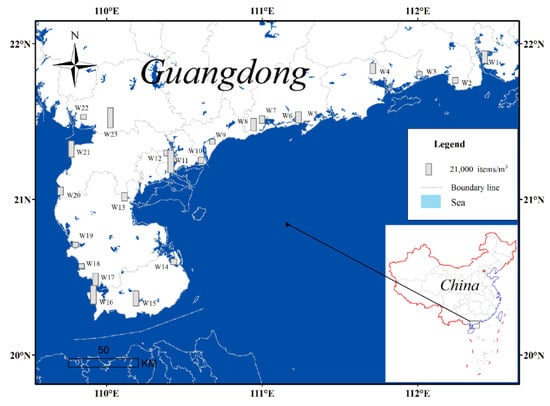
Figure 1.
The abundance of microplastics in surface water from 23 estuary areas, South China.
2.2. Fish Sampling
For fish sampling, several Mugil cephalus were purchased from local fishermen in every sampling site nearby. All fish were net-captured. Fish samples were immediately transferred to the laboratory. For each individual, total length (cm) and body weight (g) were recorded. Detailed information is shown in Supplementary Table S2 and Supplementary Figure S1. Fish samples were stored at −20 °C until further analysis for microplastic extraction.
2.3. Microplastics Extraction in Water
Water samples were incubated in the darkness with 100 mL 30% H2O2 overnight at room temperature to degrade any organic matter []. After digestion, a 0.45 μm filter paper was used for filtration. The filter papers were air-dried at room temperature and placed in Petri dishes for further analysis.
2.4. Microplastics Extraction in Fish
The preparation of fish samples was performed according to previous studies []. Fish were dissected after thawing at room temperature. The gastrointestinal tracts (GITs, from the upper esophagus to the anus) were collected and placed in 500 mL glass bottles with 200 mL KOH (10%, v/v). The GITs were incubated in a thermostatic water bath at 60 °C for 48–96 h. The gravimetric method was used to eliminate clay in fish samples. Then, 400 mL of saturated sodium chloride solution was added after initial filtration of the supernatant, and suspended at room temperature overnight. Following digestion or suspension, the solutions were filtered through 0.45 μm filter paper, which were then air-dried at room temperature and placed in glass dishes.
2.5. Quality Assurance and Control
Medical gloves, glassware, and metal tools were used throughout the experiment to treat the samples, and the dissecting tools were rinsed with distilled water three times before use. The researchers wore cotton laboratory coats during experimentation. All liquid reagents (10% KOH and saturated sodium chloride solution) were diluted with distilled water.
2.6. Observation and Description of Microplastics
The microplastics collected on filter paper were inspected using a dissection microscope following previously established protocols []. Particulates were visually sorted using a stereomicroscope (OLYMPUS SZX7, Guangzhou, China) with an eyepiece micrometer. Based on protocols from previous studies [,], microplastics were separated into different colors, sizes, and types. Details were given in Figure 2. Based on this catalogue, the size, color, and type of all microplastics were recorded from water and fish samples. Specifically, the size of microplastics was divided into three classes in terms of the longest segment: <0.5 mm, 0.5–1 mm, and 1–5 mm. The color of microplastics was divided into six categories: white, blue, green, red, yellow, and black. The type of microplastics was divided into four types: fibers, fragments, films, and spheres. The type of microplastics with unidirectional extension, toughness, softness, and non-deformability was classified as fiber. Fragment referred to the type of microplastics with irregular shape, certain thickness, and hardness extending in two or three directions. Film referred to the thin microplastics that extended in two directions, which could be easily squeezed with tweezers. The type of microplastics that was smooth and spherical was classified as sphere. These four microplastic types were all within 5 mm long under the observation of stereoscopic microscope. The type, color, and size of all microplastics from fish samples were respectively recorded.
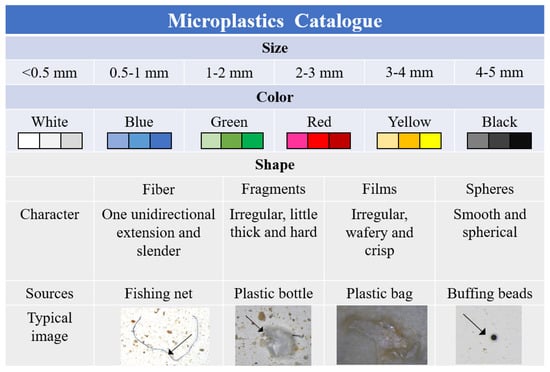
Figure 2.
The classification basis of microplastics.
In addition, scanning electron microscopy (SEM) (Hitachi S-4800, Japan) was used to obtain high-definition images of microplastics, which had higher definition than traditional single microscope. Before SEM observation, several particles were placed on double-sided tape and coated with evaporated gold, which were hard for operation.
2.7. Data Analysis
Microsoft Office Excel, SPSS 20, and GraphPad Prism were used for statistical analysis and graphing. A one-way ANOVA test was used to determine interspecies differences and spatial differences (significance level was p < 0.05).
3. Results
3.1. Characteristics and Distribution of Microplastics in Water Samples
Microplastics were widely detected in all South China surface water samples from 23 estuary areas (labeled W1–W23). The abundance of microplastics ranged from 800 to 42,800 items/m3 with an average abundance of 18,261 items/m3 (Figure 1). A relatively high abundance of microplastics was detected in W11 (42,800 items/m3), W16 (34,933 items/m3), W21 (30,533 items/m3), and W23 (37,867 items/m3), all of which were located in Zhanjiang city. Conversely, a low density of microplastics were detected in W3 (6400 items/m3) and W5 (800 items/m3), located in Yangjiang city and Maoming city, respectively (Figure 1). Therefore, Zhanjiang city suffered more serious pollution from microplastics than the other two cities.
Different proportions of the four microplastics shapes were observed across the 23 estuary areas (Figure 3A). Of all the microplastics surveyed in the surface water, fragments accounted for 81.6%, followed by fibers at 9.8%. Spheres and films only accounted for 1.4% and 1.2%, respectively. SEM images of typical microplastics are shown in Figure 4(2). The surface of the microplastic was uneven, which might create conditions for the adsorption of other pollutants. Some impurities in the water sample were easily confused with microplastics, but regular forms on the surface of the impurity could be distinguished by using SEM (Figure 4(3)). The fragments were generally irregular with uneven and raised surfaces (Figure 4(2A)). The films were also mostly irregular due to physical, chemical, or biological erosion (Figure 4(2B)). However, the appearance of impurities was mostly regular (Figure 4(3B,C)). Plastic fibers tended to corrode at one end in the environment (Figure 4(2C,D)), whereas fiber-like impurities, such as animal antennae (Figure 4(3A)), had smooth surfaces and were not easily bent. These experiences could be used as references for the observation and statistics of microplastics.
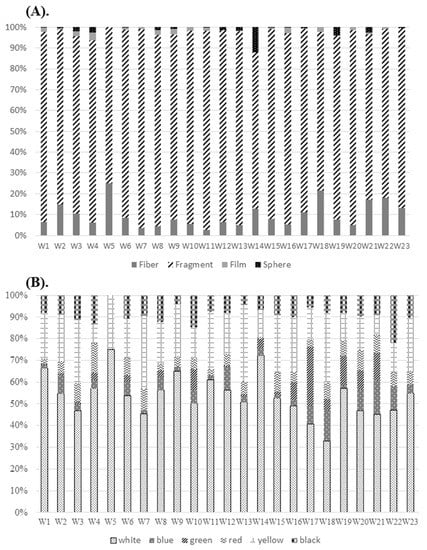
Figure 3.
Distribution of microplastics in surface water from 23 estuary areas by type (A) and color (B).
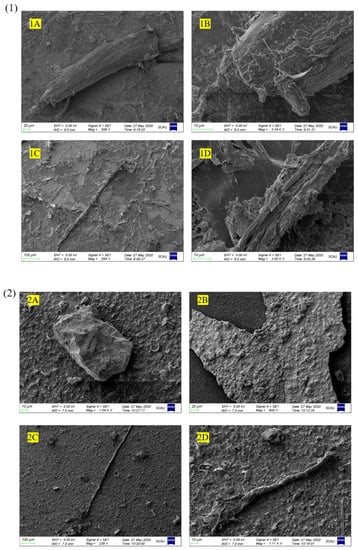
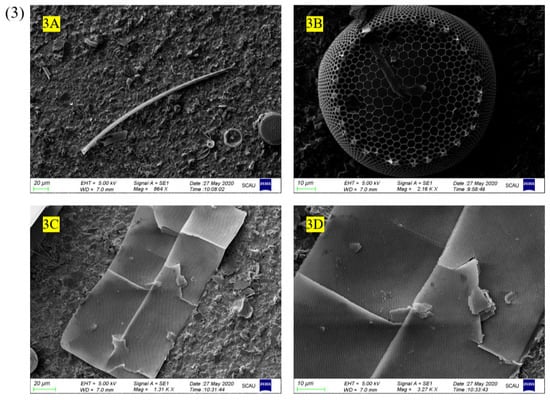
Figure 4.
High-definition image of typical microplastics by SEM from (1) estuarine mullet Mugil cephalus and (2) surface water: (1A,1B,2A,2B) fragment; (1C,1D,2C,2D) fiber; (3) other impurity from surface water (3A–3D): (1B,1D,3D) are partial enlargements of (1A,1C,3C).
Various colors of microplastics in surface water were observed, among which white and transparent were predominant (53.3%). Colored microplastics accounted for 37.3%: in particular, there was 21% yellow, 6.0% red, 5.3% blue, and 5.0% green. In addition, 9.4% of the microplastics were black. The remaining 22 samples showed at least five or more colors of microplastics except for in W5, where the smallest number of microplastics were found. Surprisingly, the most widely represented color of microplastics was yellow (Figure 3B). More than 96% of the microplastics were less than 0.5 mm, with only a small number in the 0.5–5 mm range (Figure 5A).
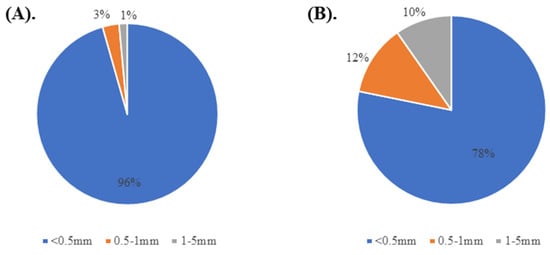
Figure 5.
Size of microplastics in surface water (A) and estuarine mullet Mugil cephalus (B) in 23 estuary areas, South China.
3.2. Characteristics and Distribution of Microplastics in Estuarine Mullet Mugil cephalus
Estuarine mullet Mugil cephalus were collected at each sampling site. In the experiment, one mullet at each sampling point was used as the experimental material to calculate the amount of microplastics ingested. A total of 23 mullets were observed, and all of them were polluted by microplastics. The abundance of microplastics in the gastrointestinal tracts (GITs) of the polluted individuals ranged from 2 to 15 (average: 7.2) items/individual, as shown in Figure 6. The abundance of microplastics in the GITs of mullet were compared with microplastics found in the surface water at each sampling point (Figure 6). The results showed no correlation between microplastics in the environment and microplastics found in the mullet GIT. This was a surprising result and not what we had hypothesized.
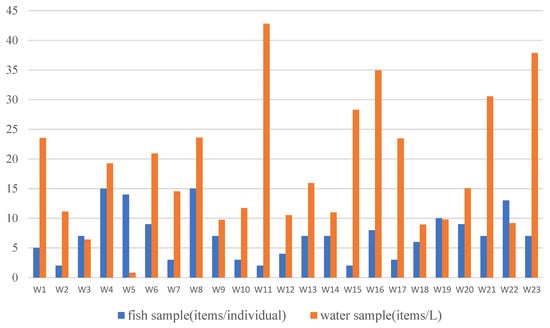
Figure 6.
The abundance of microplastics in surface water and estuarine mullet Mugil cephalus from 23 estuary areas, South China.
The four distinct shapes of microplastics were also observed in fish samples. However, the proportion of microplastics shapes in mullets was different among the 23 estuary areas (Figure 7A). Therein, fragments were the most dominant shape, accounting for 60.8%, followed by fibers at 36.0%. Spheres and films only accounted for 0.7% and 2.5%, respectively. High-definition images of typical microplastics analyzed by SEM are shown in Figure 4(1). Specifically, the surface of fragments and fibers were worn and unregulated. Regarding the color of microplastics, the proportion of colors ingested by mullets was similar to that of the surface water. The main color of microplastics observed was white and transparent, constituting 45.4%. Colored microplastics account for 38.8%, with yellow being the most abundant at 24.2%, followed by blue 7.9%, red 4.9%, and green 1.8%. Black microplastics account for 15.8%. Mullet in W7 had only white microplastics, while mullet in W9, W13, or W19 did not have white microplastics in the GIT. The mullet samples obtained from eight sampling sites showed two colors, and the mullet samples obtained from six sampling sites had three colors. Only three mullet samples had five colors (Figure 7B). Over 78% of the microplastics were <0.5 mm in size. Microplastics ranging 0.5–1 mm in size accounted for 12%, and microplastics ranging from 1–5 mm accounted for 10% (Figure 5B).
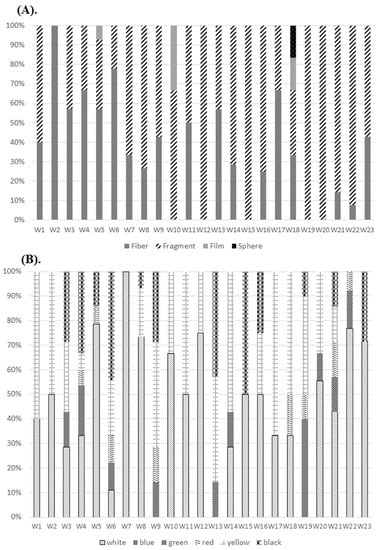
Figure 7.
Distribution of microplastics in estuarine mullet Mugil cephalus from 23 estuary areas by type (A) and color (B).
4. Discussion
4.1. Characteristics and Distribution of Microplastics in Surface Water
In this study, the average abundance of microplastics in surface water from the western estuary areas of Guangdong was 18,261 items/m3. This value was much higher than from the eastern coastal areas of Guangdong which was 8895 items/m3 []. The economic development of the eastern and western Guangdong province is similar, so the difference caused by geographical location was excluded. It is proposed that these results were caused by the serious pollution problem in the estuary area. Other research showed the average abundance of microplastics was 19,860 items/m3 and 8902 items/m3 in the urban section and estuary along Pearl River, respectively []. The estuaries in the present study are different from delta estuaries but closer to urban inland rivers, which were significantly affected by human activity. The abundance of microplastics in most of the small bodies of water from the Yangtze River Delta was in the range of 1–5 items/L, far lower than the results in this study []. The serious problem of microplastic pollution in estuarine areas of South China is worth investigating, and the source of pollution must be controlled.
In terms of microplastic types, the vast majority in this study were fragments, accounting for 81.6% of the microplastics found. The shape of the microplastics in an urban river of Guangzhou city was primarily composed of fibers (80.9%) []. Polystyrene foam is the most abundant type of plastic debris (96%) on the coast of Guangdong province []. However, in the Zhubi Reef located in the South China Sea, fibers and pellets comprised the most common microplastic types []. The three field research sites listed above are all located in South China; however, the results presented here were different, more in line with Liu et al. [], where they also found that fragments were the most predominant shape in the surface seawater of Jiaozhou Bay.
Regarding the color of the microplastics, white and transparent were predominant (53.3%) among the microplastics in surface water, where colored microplastics account for 37.3%. In another estuarine area of China, the Changjiang Estuary, colored particles (including blue, pink, and gray) comprised the majority of the microplastics in the collected samples (76.7%), where transparent particles only represented 5.1% []. In addition to China, in Victoria, Australia, blue was the dominant microplastic color in both water (45%) and shrimp samples (90%) []. In the southwest coast of India, colored particles (including green, red, yellow, blue, and violet) comprised the majority of the microplastics the in collected coastal water samples (70%) [].
More than 96% of the microplastics found in the present study were less than 0.5 mm. However, approximately 500 km from the research sites, the typical size of the plastic particles ranged from 0.6 to 2mm (41.36%) in the Feilaixia Reservoir []. Microplastics within the size range of 0.1–1 mm were predominant in the surface water of the entire watershed in the Guangdong–Hong Kong–Macao Greater Bay Area []. Baldwin et al. surveyed 29 of the world’s great lakes and found that 72% of microplastics were within the range of 0.35–0.99 mm in size []. The microplastics surveyed in this study were too small to be identified by Fourier-transform infrared spectroscopy (FTIR) or Raman spectroscopy. Rather, SEM was used to obtain high-definition images of the particles collected in the water samples. At high magnification, impurities could be easily distinguished. Impurities such as fibers similar to torn tentacles of certain aquatic organisms (Figure 4(3A)), algae-like fragments (Figure 4(3B)), and mesh-like films (Figure 4(3C)) had a symmetrical and regular surface.
Since the outbreak of COVID-19 at the end of 2019, masks, protective suits, and test kits have constituted a large number of global consumption materials. The use and abandonment of disposable plastic products might have greatly increased the level of microplastic pollution, making it more necessary to strengthen the supervision and control of plastic pollution. Attention should be paid to the real-time supervision of microplastic pollution. More importantly, it is urgent to emphasize the recycling and reuse of plastic wastes. In the face of the increasingly serious plastic pollution problem, how to rationally place and manage it is a great test for the sustainable development of humans and nature.
4.2. Characteristics and Distribution of Microplastics in Fish
In the present report, the average abundance of microplastics in the GITs of the mullets tested was 7.2 items/individual. In a related study, the average abundance in fish from the Zhanjiang mangrove wetland was 2.83 ± 1.84 items/individual [], which was much lower than what was found in our study. According to the data from our laboratory [] and unpublished data, mullets consume more microplastics than other fish. The average abundance of microplastics in the GITs of M. cephalus from the coastal waters of the eastern equatorial Atlantic Ocean was 67.2 items/individual, which had the highest number of microplastics among the seven investigated species []. A high microplastic ingestion rate was also observed in the Mugil cephalus in the northeastern Mediterranean, for which the average abundance was 46.4 items/individual []. The average abundance of microplastics in the GITs of Mugil cephalus in the estuary of Minho River was 10.42 items/individual []. The high loads of microplastics in the GITs of mullets might be due to their broader diet and habitat preference []. M. cephalus are omnivorous and feed on a wide variety of foods, such as zooplankton, microalgae, bivalves, and smaller fishes, which may increase the probability of ingesting microplastics by accident. Furthermore, M. cephalus habitats include marine, brackish, and freshwater environments, and they prefer to live at the bottom of the water. Adaptations in diverse water environments make it possible for mullets to be exposed to more microplastics.
Of all the microplastics surveyed in the GITs of mullets, the shape, color, and size were similar to those of surface water. Generally, fibers of a transparent color were most common in freshwater ecosystems [] and in most of the microplastics ingested by fish []. For example, the main type of microplastics found in M. cephalus (48.9%) in the cities’ streams of East Anatolia of Türkiye was fiber (48.9%), and the dominant color was black (83.0%) []. Of the 249 microplastics found in the GITs of fish in Sydney Harbour, 83% were fibrous and 17% were granular in shape []. However, fragments were the most dominant shape found in the fish samples (60.8%) in this study, and yellow microplastics account for 24.2%, which was closely related to the shape and color of the microplastics in the water samples. Of all the microplastics surveyed in the surface water, fragments accounted for 81.6%, followed by fibers at 9.8%. The microplastics ingested by fish must have come from water bodies or sediments, which explained why fragments were the predominant type of microplastics found in the fish in this investigation. In particular, the proportion of microplastics <0.5 mm in fish samples was smaller than that in water samples, so it is speculated that microplastics of a relatively small size were more likely to be excreted by fish.
Economic polluted fish are directly consumed by human beings, which might endanger human food safety, safety, and health. Ingestion was thought to be the main route by which microplastics enter the body []. Based on food consumption, the annual intake of microplastics was estimated at 39,000 to 52,000 per person []. Microplastics reach the gastrointestinal system via contaminated food and might cause inflammatory responses, an increase in vascular permeability, and change in gut microbial composition and metabolism []. Once considered inert particles with no toxicity, microplastics are now considered potentially harmful to organisms, depending on exposure and susceptibility []. The high surface area of microplastics may cause oxidative stress, cytotoxicity, and transfer to other tissues. Their persistence limits their removal from organs, causing chronic inflammation, increasing the risk of cancer, and increasing the incidence of immune or neurodegenerative diseases []. In addition, microplastics might adsorb or release chemicals from their substrates or from the environment and act as vectors for dangerous micro-organisms []. Investigating fish microplastic ingestion enables a better understanding of the threat of microplastics to food webs and possibly human health. Given the important role of fish as a source of protein for humans, continued studies are strongly recommended to demonstrate the ecotoxicological effects of microplastics on fish from the individual to the population level and to scientifically assess the threat to fish sustainability.
5. Conclusions
In the present study, we report serious pollution due to microplastics in 23 estuary areas in southern China. The average microplastics abundance was 18,261 items/m3 in surface water, and 7.2 items/individual in Mugil cephalus. Fragments and micro size were the most common features. The shape, color, and size of the microplastics in fish and water samples were similar, showing that the microplastics in water enter the organism and may eventually affect humans. The study revealed the serious microplastics contamination of the water and commercial fish in estuarine systems, and sounded the alarm for the supervision and governance of plastic wastes. Future work should focus on the risk of microplastics contaminants being passed down the food chain to humans.
Supplementary Materials
The following supporting information can be downloaded at: https://www.mdpi.com/article/10.3390/su15054193/s1, Figure S1: Some pictures of Mugil cephalus; Table S1: Information of the sampling sties; Table S2. Information of the sampling fish, Mugil cephalus.
Author Contributions
Methodology, C.Z., S.W. and D.S.; Software, Z.P.; Validation, J.Z.; Investigation, S.W., D.S. and Z.P.; Resources, S.W. and D.S.; Data curation, S.W.; Writing—original draft, C.Z.; Writing—review & editing, C.Z.; Supervision, J.Z.; Project administration, J.Z.; Funding acquisition, J.Z. All authors have read and agreed to the published version of the manuscript.
Funding
This research was funded by the Key Realm R&D Program of Guangdong Province (No. 2020B0202080005), and China Agriculture Research System of MOF and MARA (CARS-45-50).
Institutional Review Board Statement
Not applicable.
Informed Consent Statement
Not applicable.
Data Availability Statement
Not applicable.
Conflicts of Interest
The authors report no conflict of interest.
References
- Arthur, C.; Baker, J.; Bamford, H. Proceedings of the International Research Workshop on the Occurrence, Effects, and Fate of Microplastic Marine Debris; University of Washington Tacoma: Tacoma, WA, USA, 2008. [Google Scholar]
- Thompson, R.C.; Olsen, Y.; Mitchell, R.P.; Davis, A.; Rowland, S.J.; John, A.W.G.; Russell, A.E. Lost at sea: Where is all the plastic? Science 2004, 304, 838. [Google Scholar] [CrossRef]
- Carbery, M.; O’Connor, W.; Palanisami, T. Trophic transfer of microplastics and mixed contaminants in the marine food web and implications for human health. Environ. Int. 2018, 115, 400–409. [Google Scholar] [CrossRef]
- Jacob, H.; Besson, M.; Swarzenski, P.W.; Lecchini, D.; Metian, M. Effects of Virgin Micro- and Nanoplastics on Fish: Trends, Meta-Analysis, and Perspectives. Environ. Sci. Technol. 2020, 54, 4733–4745. [Google Scholar] [CrossRef] [PubMed]
- Rochman, C.M.; Kross, S.M.; Armstrong, J.B.; Bogan, M.T.; Darling, E.S.; Green, S.J.; Smyth, A.R.; Veríssimo, D. Scientific Evidence Supports a Ban on Microbeads. Environ. Sci. Technol. 2015, 49, 10759–10761. [Google Scholar] [CrossRef] [PubMed]
- Brennecke, D.; Duarte, B.; Paiva, F.; Caçador, I.; Canning-Clode, J. Microplastics as vector for heavy metal contamination from the marine environment. Estuar. Coast. Shelf Sci. 2016, 178, 189–195. [Google Scholar] [CrossRef]
- Li, W.; Zu, B.; Yang, Q.; Huang, Y.; Li, J. Adsorption of lead and cadmium by microplastics and their desorption behavior as vectors in the gastrointestinal environment. J. Environ. Chem. Eng. 2022, 10, 107379. [Google Scholar] [CrossRef]
- Bhagat, K.; Barrios, A.C.; Rajwade, K.; Kumar, A.; Oswald, J.; Apul, O.; Perreault, F. Aging of microplastics increases their adsorption affinity towards organic contaminants. Chemosphere 2022, 298, 134238. [Google Scholar] [CrossRef]
- Verdú, I.; Amariei, G.; Rueda-Varela, C.; González-Pleiter, M.; Leganés, F.; Rosal, R.; Fernández-Piñas, F. Biofilm formation strongly influences the vector transport of triclosan-loaded polyethylene microplastics. Sci. Total Environ. 2023, 859, 160231. [Google Scholar] [CrossRef]
- Fu, W.; Min, J.; Jiang, W.; Li, Y.; Zhang, W. Separation, characterization and identification of microplastics and nanoplastics in the environment. Sci. Total Environ. 2020, 721, 137561. [Google Scholar] [CrossRef]
- Zhou, W.; Han, Y.; Tang, Y.; Shi, W.; Du, X.; Sun, S.; Liu, G. Microplastics aggravate the bioaccumulation of two waterborne veterinary antibiotics in an edible bivalve species: Potential mechanisms and implications for human health. Environ. Sci. Technol. 2020, 54, 8115–8122. [Google Scholar] [CrossRef]
- Gorbi, S.; Baldini, C.; Regoli, F. Seasonal Variability of Metallothioneins, Cytochrome P450, Bile Metabolites and Oxyradical Metabolism in the European Eel Anguilla anguilla L. (Anguillidae) and Striped Mullet Mugil cephalus L. (Mugilidae). Arch. Environ. Contam. Toxicol. 2005, 49, 62–70. [Google Scholar] [CrossRef] [PubMed]
- Guilhermino, L.; Martins, A.; Lopes, C.; Raimundo, J.; Vieira, L.R.; Barboza, L.G.A.; Costa, J.; Antunes, C.; Caetano, M.; Vale, C. Microplastics in fishes from an estuary (Minho River) ending into the NE Atlantic Ocean. Mar. Pollut. Bull. 2021, 173, 113008. [Google Scholar] [CrossRef] [PubMed]
- Ouali, N.; Belabed, B.; Chenchouni, H. Modelling environment contamination with heavy metals in flathead grey mullet Mugil cephalus and upper sediments from north African coasts of the Mediterranean Sea. Sci. Total Environ. 2018, 639, 156–174. [Google Scholar] [CrossRef]
- Naidoo, T.; Smit, A.J.; Glassom, D. Plastic ingestion by estuarine mullet Mugil cephalus (Mugilidae) in an urban harbour, KwaZulu-Natal, South Africa. Afr. J. Mar. Sci. 2016, 38, 145–149. [Google Scholar] [CrossRef]
- Halstead, J.E.; Smith, J.A.; Carter, E.A.; Lay, P.A.; Johnston, E.L. Assessment tools for microplastics and natural fibres ingested by fish in an urbanised estuary. Environ. Pollut. 2018, 234, 552–561. [Google Scholar] [CrossRef]
- Zhang, C.; Wang, S.; Sun, D.; Pan, Z.; Zhou, A.; Xie, S.; Wang, J.; Zou, J. Microplastic pollution in surface water from east coastal areas of Guangdong, South China and preliminary study on microplastics biomonitoring using two marine fish. Chemosphere 2020, 256, 127202. [Google Scholar] [CrossRef]
- Song, Y.K.; Hong, S.H.; Eo, S.; Jang, M.; Han, G.M.; Isobe, A.; Shim, W.J. Horizontal and Vertical Distribution of Microplastics in Korean Coastal Waters. Environ. Sci. Technol. 2018, 52, 12188–12197. [Google Scholar] [CrossRef]
- Yan, M.; Nie, H.; Xu, K.; He, Y.; Hu, Y.; Huang, Y.; Wang, J. Microplastic abundance, distribution and composition in the Pearl River along Guangzhou city and Pearl River estuary, China. Chemosphere 2019, 217, 879–886. [Google Scholar] [CrossRef] [PubMed]
- Nie, H.; Wang, J.; Xu, K.; Huang, Y.; Yan, M. Microplastic pollution in water and fish samples around Nanxun Reef in Nansha Islands, South China Sea. Sci. Total Environ. 2019, 696, 134022. [Google Scholar] [CrossRef] [PubMed]
- Jabeen, K.; Su, L.; Li, J.; Yang, D.; Tong, C.; Mu, J.; Shi, H. Microplastics and mesoplastics in fish from coastal and fresh waters of China. Environ. Pollut. 2017, 221, 141–149. [Google Scholar] [CrossRef]
- Zheng, K.; Fan, Y.; Zhu, Z.; Chen, G.; Tang, C.; Peng, X. Occurrence and Species-Specific Distribution of Plastic Debris in Wild Freshwater Fish from the Pearl River Catchment, China. Environ. Toxicol. Chem. 2019, 38, 1504–1513. [Google Scholar] [CrossRef] [PubMed]
- Hu, L.; Chernick, M.; Hinton, D.E.; Shi, H. Microplastics in Small Waterbodies and Tadpoles from Yangtze River Delta, China. Environ. Sci. Technol. 2018, 52, 8885–8893. [Google Scholar] [CrossRef]
- Lin, L.; Zuo, L.; Peng, J.; Cai, L.; Fok, L.; Yan, Y.; Li, H.; Xu, X. Occurrence and distribution of microplastics in an urban river: A case study in the Pearl River along Guangzhou City, China. Sci. Total Environ. 2018, 644, 375–381. [Google Scholar] [CrossRef] [PubMed]
- Fok, L.; Cheung, P.K.; Tang, G.; Li, W.C. Size distribution of stranded small plastic debris on the coast of Guangdong, South China. Environ. Pollut. 2017, 220, 407–412. [Google Scholar] [CrossRef] [PubMed]
- Huang, Y.; Yan, M.; Xu, K.; Nie, H.; Gong, H.; Wang, J. Distribution characteristics of microplastics in Zhubi Reef from South China Sea. Environ. Pollut. 2019, 255, 113133. [Google Scholar] [CrossRef]
- Liu, T.; Zhao, Y.; Zhu, M.; Liang, J.; Zheng, S.; Sun, X. Seasonal variation of micro- and meso-plastics in the seawater of Jiaozhou Bay, the Yellow Sea. Mar. Pollut. Bull. 2020, 152, 110922. [Google Scholar] [CrossRef]
- Xu, P.; Peng, G.; Su, L.; Gao, Y.; Gao, L.; Li, D. Microplastic risk assessment in surface waters: A case study in the Changjiang Estuary, China. Mar. Pollut. Bull. 2018, 133, 647–654. [Google Scholar] [CrossRef]
- Nan, B.; Su, L.; Kellar, C.; Craig, N.J.; Keough, M.J.; Pettigrove, V. Identification of microplastics in surface water and Australian freshwater shrimp Paratya australiensis in Victoria, Australia. Environ. Pollut. 2020, 259, 113865. [Google Scholar] [CrossRef]
- Robin, R.S.; Karthik, R.; Purvaja, R.; Ganguly, D.; Anandavelu, I.; Mugilarasan, M.; Ramesh, R. Holistic assessment of microplastics in various coastal environmental matrices, southwest coast of India. Sci. Total Environ. 2020, 703, 134947. [Google Scholar] [CrossRef]
- Tan, X.; Yu, X.; Cai, L.; Wang, J.; Peng, J. Microplastics and associated PAHs in surface water from the Feilaixia Reservoir in the Beijiang River, China. Chemosphere 2019, 221, 834–840. [Google Scholar] [CrossRef]
- Wu, P.; Tang, Y.; Dang, M.; Wang, S.; Jin, H.; Liu, Y.; Jing, H.; Zheng, C.; Yi, S.; Cai, Z. Spatial-temporal distribution of microplastics in surface water and sediments of Maozhou River within Guangdong-Hong Kong-Macao Greater Bay Area. Sci. Total Environ. 2020, 717, 135187. [Google Scholar] [CrossRef] [PubMed]
- Baldwin, A.K.; Corsi, S.R.; Mason, S.A. Plastic Debris in 29 Great Lakes Tributaries: Relations to Watershed Attributes and Hydrology. Environ. Sci. Technol. 2016, 50, 10377–10385. [Google Scholar] [CrossRef] [PubMed]
- Huang, J.; Koongolla, J.B.; Li, H.; Lin, L.; Pan, Y.; Liu, S.; He, W.; Maharana, D.; Xu, X. Microplastic accumulation in fish from Zhanjiang mangrove wetland, South China. Sci. Total Environ. 2020, 708, 134839. [Google Scholar] [CrossRef]
- Edem, M.; Wise, G.D.; Regina, F.; Jerome, F.; Richard, C.; Robert, M.; Judith, M.; Mario, C.B.; Maurice, E.O.; Margret, N.O.; et al. Human health risk and food safety implications of microplastic consumption by fish from coastal waters of the eastern equatorial Atlantic Ocean. Food Control 2023, 145, 109503. [Google Scholar]
- Kilic, E.; Yucel, N. Microplastic occurrence in the gastrointestinal tract and gill of bioindicator fish species in the northeastern Mediterranean. Mar. Pollut. Bull. 2022, 177, 113556. [Google Scholar] [CrossRef]
- Fu, Z.; Wang, J. Current practices and future perspectives of microplastic pollution in freshwater ecosystems in China. Sci. Total Environ. 2019, 691, 697–712. [Google Scholar] [CrossRef]
- Atamanalp, M.; Kokturk, M.; Kırıcı, M.; Ucar, A.; Kırıcı, M.; Parlak, V.; Aydın, A.; Alak, G. Interaction of Microplastic Presence and Oxidative Stress in Freshwater Fish: A Regional Scale Research, East Anatolia of Türkiye (Erzurum & Erzincan & Bingöl). Sustainability 2022, 14, 12009. [Google Scholar]
- Galloway, T. Micro- and nano-plastic and human health. Mar. Anthropog. Litter 2015, 343–366. [Google Scholar] [CrossRef]
- Cox, K.D.; Covernton, G.A.; Davies, H.L.; Dower, J.F.; Juanes, F.; Dudas, S.E. Human consumption of microplastics. Environ. Sci. Technol. 2019, 53, 7068–7074. [Google Scholar] [CrossRef]
- Salim, S.; Kaplan, G.; Madsen, K. Air pollution effects on the gut microbiota: A link between exposure and inflammatory disease. Gut Microbes 2014, 5, 215–219. [Google Scholar] [CrossRef]
- Anbymani, S.; Kakkar, P. Ecotoxicological effects of microplastics in biota: A review. Environ. Sci. Pollut. Res. 2018, 25, 14373–14396. [Google Scholar] [CrossRef] [PubMed]
- Prata, C.J.; Da, C.; Joao, P.; Lopes, I. Environmental exposure to microplastics: An overview on possible human health effects. Sci. Total Environ. 2020, 702, 134455. [Google Scholar] [CrossRef] [PubMed]
- Kirstein, I.; Kirmizi, S.; Wichels, A.; Garin-Fernandez, R. Dangerous hitchhikers? Evidence for potentially pathogenic Vibrio spp. on microplastic particles. Mar. Environ. Res. 2016, 120, 1–8. [Google Scholar] [CrossRef] [PubMed]
Disclaimer/Publisher’s Note: The statements, opinions and data contained in all publications are solely those of the individual author(s) and contributor(s) and not of MDPI and/or the editor(s). MDPI and/or the editor(s) disclaim responsibility for any injury to people or property resulting from any ideas, methods, instructions or products referred to in the content. |
© 2023 by the authors. Licensee MDPI, Basel, Switzerland. This article is an open access article distributed under the terms and conditions of the Creative Commons Attribution (CC BY) license (https://creativecommons.org/licenses/by/4.0/).